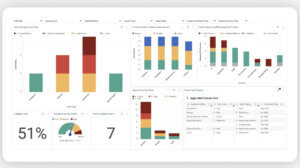California’s Senate Bill 553 came into effect on July 1, 2024, introducing critical requirements for workplace violence prevention. For corporate security leaders, SB 553 compliance is essential — not just to avoid penalties, but to foster a culture of safety and accountability.
Following California’s lead, New York recently passed the Retail Worker Safety Act, signed by Governor Kathy Hochul on September 4, 2024. This legislation marks another significant step forward in workplace violence prevention across the United States.
Understanding the nuances of SB 553 can be a challenge. The stakes are high when it comes to securing cross-departmental collaboration, maintaining accurate incident logs, and preparing for audits. However, choosing the right tools, like Resolver’s Incident Management Software, can make compliance much more manageable.
We spoke with a corporate security leader from a leading, globally known company based in California who has been using Resolver to drive SB 553 compliance efforts. Their experience sheds light on how businesses are successfully adapting to these new regulations.
What are the requirements for SB 553 compliance?
California’s SB 553 represents a pivotal step in workplace violence prevention. The law requires businesses with 10 or more employees to create and maintain a comprehensive workplace violence prevention plan as an effort to make workplaces safer. With this legislation, organizations are ready to handle incidents effectively and responsibly.
SB 553 compliance has four core requirements for businesses:
- Workplace violence prevention plan: Develop a clear plan for identifying, reporting, and responding to incidents.
- Incident reporting and logging: Maintain detailed records of all incidents to ensure accurate, timely reporting.
- Employee training: Conduct regular training sessions to help employees identify threats and respond to incidents.
- Stakeholder involvement: Engage HR, legal, and security teams in meeting SB 553 compliance and reporting requirements.
The New York Retail Worker Safety Act mirrors many of these requirements while adding specific provisions for retail workers. Like SB 553, it applies to businesses with 10 or more employees, though it focuses specifically on retail stores that sell consumer commodities.
For a more detailed overview of the legislation, including specific provisions and compliance strategies, you can refer to our comprehensive California Bill 553 compliance guide.
Developing an effective workplace violence prevention plan
A strong prevention plan is the foundation for SB 553 compliance. The new legal requirements requires organizations to ensure they’re thoroughly documenting, investigating, and reporting any incidents of workplace violence.
Cross-departmental collaboration plays a significant role in building a plan that works. According to the security leader we interviewed, “Part of what SB 553 requires is for you to bring multiple departments to the table. You need to create a holistic plan that leverages all functions within the organization.”
The team began by evaluating their current policies to find gaps and areas for improvement. By leveraging Resolver’s Incident Management Software, they were able to tailor their prevention plan to the company’s specific needs. The software simplified compliance tracking and reporting, centralizing incident data and streamlining communication between departments. This not only ensured readiness for audits but also reduced errors in documentation, making the entire Senate Bill 553 reporting process more efficient and transparent.
Discover strategies for cross-departmental collaboration
Overcoming common SB 553 compliance challenges
Implementing the changes required by SB 553 was daunting for some organizations. Many found themselves facing unexpected hurdles that complicated the process, making it difficult to stay on track. Below are some common challenges and the strategies that helped this organization overcome them.
Cross-team alignment
“Getting everyone on board was one of the biggest challenges,” the security leader shared. Regular task force meetings that brought together HR, legal, and security teams were essential for maintaining clear communication and collaboration, ensuring everyone stayed aligned and committed throughout the process.
Interdepartmental communication
Coordinating responses across different departments can also be tricky, especially when teams don’t traditionally work closely together. “It’s not uncommon for HR to respond to an incident without involving security or legal,” the security leader noted. By using Resolver, they ensured that all relevant teams stayed connected and regularly communicated during incident responses.
Adapting existing processes
Adjusting current processes to meet SB 553 compliance requirements can be complex. “We already had a solid response process in place. The real challenge was adapting it to capture a little more data,” they explained. Leveraging the flexibility of Resolver, the team customized fields to capture all the data needed for compliance reporting.
The New York law introduces a unique requirement for larger retailers. Starting January 2027, businesses with over 500 retail employees nationwide must provide panic buttons that connect directly to local emergency services. Companies can choose between stationary panic buttons throughout the workplace or wearable/mobile phone-based options.
Audit readiness
Maintaining detailed records to be prepared for audits is another critical aspect of SB 553. “You don’t want to scramble when a regulator asks for information,” said the security leader. Resolver helped their team record incidents in real-time, making data readily available for audits, with ongoing internal reviews to maintain accuracy.

Watch our on-demand webinar for more tips and tricks on cross-team investigations
Benefits of Incident Management Software for SB 553 compliance
Resolver’s Incident Management Software played a crucial role in simplifying compliance for this company. “The software made it easy to track and report incidents,” the security leader shared. “It also gave us insights into our safety practices and areas for improvement.”
By using Resolver, the organization improved data management, streamlined reporting, and enhanced collaboration across departments. “It’s about more than just meeting regulatory requirements. It’s about creating a safer, more secure workplace for everyone.”
Being proactive about workplace violence prevention not only ensures compliance but also enhances the overall safety and well-being of employees. It positions your organization as a leader in safety and responsibility, fostering trust and confidence among employees, stakeholders, and clients.
Learn more in our Workplace Violence Prevention & Compliance Guide
Taking action toward a safer workplace
We know your role involves juggling numerous responsibilities and that delivering on SB 553 compliance can feel overwhelming. But with the right tools and strategies, you can transform this challenge into an opportunity to lead your organization towards a safer, more secure future.
With both California — and now New York — implementing new workplace violence prevention laws, we expect to see similar legislation across other states. Organizations that create strong prevention programs now will be better positioned to adapt as requirements evolve.
SB 553 represents a significant step forward in workplace safety. By understanding the law, using the right tools, and fostering a culture of safety, businesses don’t just comply with regulations, but also create a more secure environment for their employees.
Explore Resolver’s innovative risk management solutions for retail security and compliance. Book a demo today to see how we can help your business meet California’s Bill 553 requirements.
